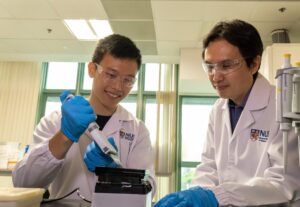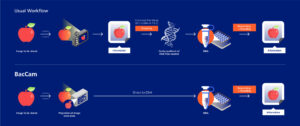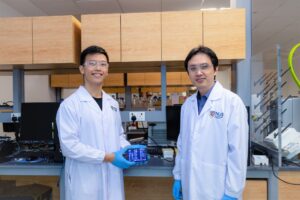Researchers at NUS CDE pioneer an innovative ‘biological camera’ that ushers in a new paradigm of information storage.
In a world first, a ‘biological camera’ bypasses the constraints of current DNA storage methods, harnessing living cells and their inherent biological mechanisms to encode and store data. This represents a significant breakthrough in encoding and storing images directly within DNA, creating a new model for information storage reminiscent of a digital camera.
Led by Principal Investigator Associate Professor Chueh Loo Poh from the College of Design and Engineering at the National University of Singapore, and the NUS Synthetic Biology for Clinical and Technological Innovation (SynCTI), the team’s findings, which could potentially shake up the data-storage industry, were published in Nature Communications on 03 July 2023 (https://www.nature.com/articles/s41467-023-38876-w ).

Graduate student Cheng Kai Lim and Associate Professor Chueh Loo Poh have developed a novel way to capture and store images directly into DNA.
A new paradigm to address global data overload
As the world continues to generate data at an unprecedented rate, data has come to be seen as the ‘currency’ of the 21st century. Estimated to be 33 ZB in 2018, it has been forecasted that the Global Datasphere will reach 175 ZB by 2025. That has sparked a quest for a storage alternative that can transcend the confines of conventional data storage and address the environmental impact of resource-intensive data centres.
It is only recently that the idea of using DNA to store other types of information, such as images and videos, has garnered attention. This is due to DNA’s exceptional storage capacity, stability, and long-standing relevance as a medium for information storage.
“We are facing an impending data overload. DNA, the key biomaterial of every living thing on Earth, stores genetic information that encodes for an array of proteins responsible for various life functions. To put it into perspective, a single gram of DNA can hold over 215,000 terabytes of data – equivalent to storing 45 million DVDs combined,” said Poh.
“DNA is also easy to manipulate with current molecular biology tools, can be stored in various forms at room temperature, and is so durable it can last centuries”, says Cheng Kai Lim, a graduate student working with Poh.
Despite its immense potential, current research in DNA storage focuses on synthesising DNA strands outside the cells. This process is expensive and relies on complex instruments, which are also prone to errors.
To overcome this bottleneck, Poh and his team turned to live cells, which contain an abundance of DNA that can act as a ‘data bank’, circumventing the need to synthesise the genetic material externally.
Through sheer ingenuity and clever engineering, the team developed ‘BacCam’ - a novel system that merges various biological and digital techniques to emulate a digital camera’s functions using biological components.
“Imagine the DNA within a cell as an undeveloped photographic film,” explained Poh. “Using optogenetics – a technique that controls the activity of cells with light akin to the shutter mechanism of a camera, we managed to capture ‘images’ by imprinting light signals onto the DNA ‘film’.”
Next, using barcoding techniques akin to photo labelling, the researchers marked the captured images for unique identification. Machine-learning algorithms were employed to organise, sort, and reconstruct the stored images. These constitute the ‘biological camera’, mirroring a digital camera's data capture, storage, and retrieval processes.

Comparison of workflows for image capture and DNA storage showing BacCam’s improved Direct-to-DNA process
The study showcased the camera’s ability to capture and store multiple images simultaneously using different light colours. More crucially, compared to earlier methods of DNA data storage, the team’s innovative system is easily reproducible and scalable.

The BacCam device showing ‘NUS’ – one of many images the image successfully captured in the bacterial DNA
“As we push the boundaries of DNA data storage, there is an increasing interest in bridging the interface between biological and digital systems,” said Poh.
“Our method represents a major milestone in integrating biological systems with digital devices. By harnessing the power of DNA and optogenetic circuits, we have created the first 'living digital camera,' which offers a cost-effective and efficient approach to DNA data storage. Our work not only explores further applications of DNA data storage but also re-engineers existing data-capture technologies into a biological framework. We hope this will lay the groundwork for continued innovation in recording and storing information.”
This story first appeared at the College of Design and Engineering, NUS. Original link here. The video and images are reproduced with permission from CDE, NUS.



